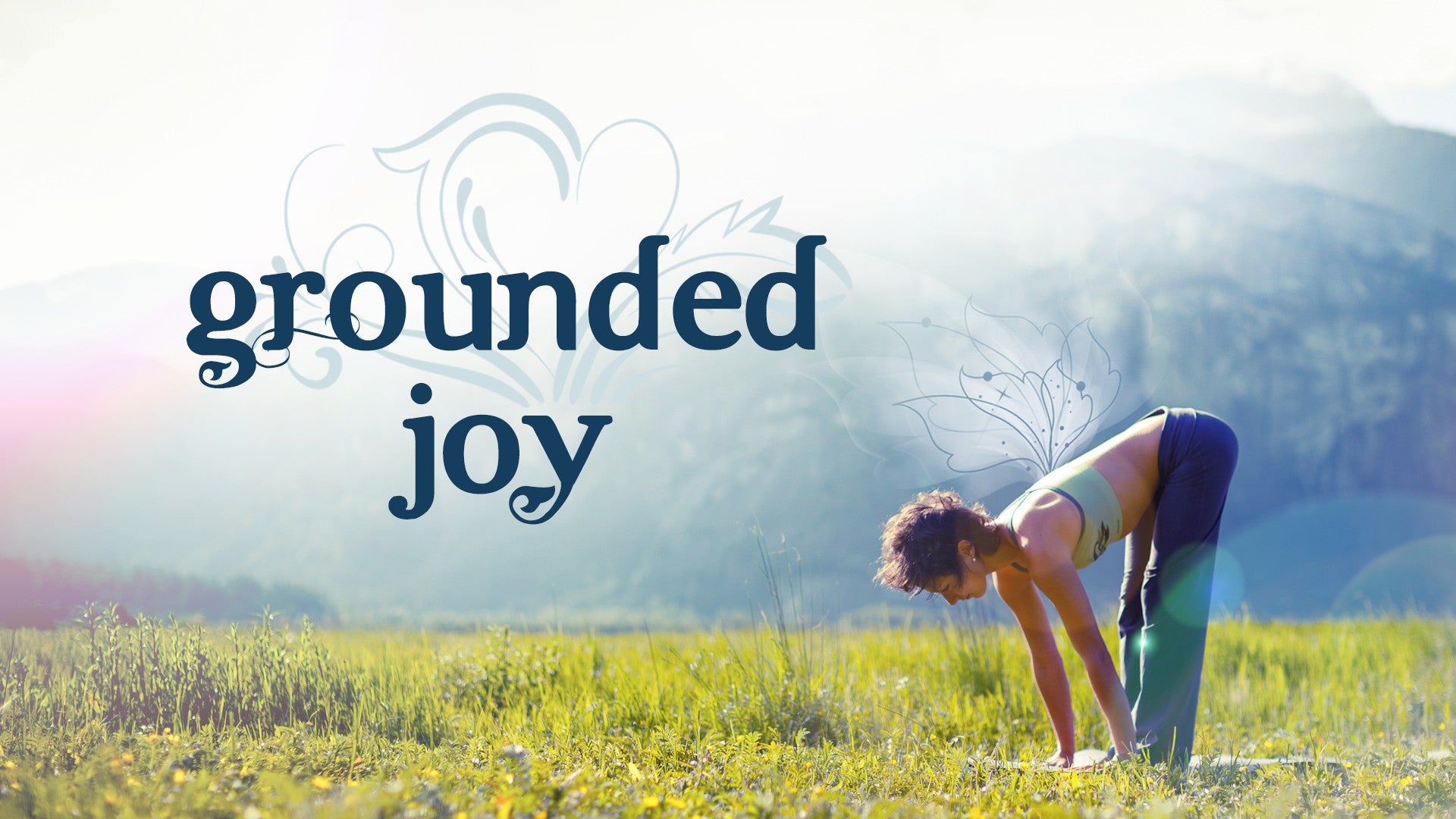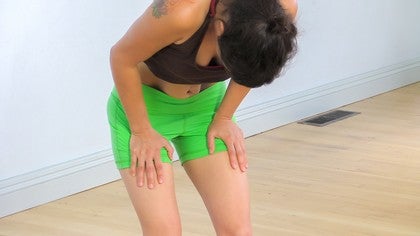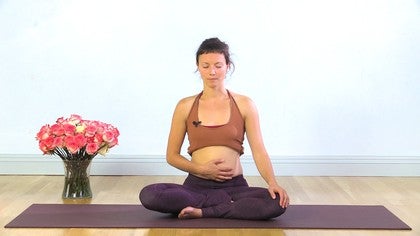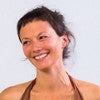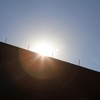Description
Transcript
Read Full Transcript
(gentle lapping) Hi. So in this class, I thought we'd take a look at backbending with a deep front body and a wide back body. So what often happens in backbending is we push the spine into the body and you might have felt that compressive feeling that happens in backbending. And it's sort of a feeling of really narrowing and shortening the spine. So let's come up to standing and take a look at how we can keep the abdominal wall deep and the front of the body deeper, and the back of the body wider.
So when we take our arms up and over the head we're gonna think about these two areas, the groin area, and the armpit area, as sort of nests. So we can keep them deep, without popping them forwards, and sort of popping the abdomen forwards and popping the chest forwards. So we actually want to pull the two frontal hipbones together, feel this, sort of like this bikini line area is deep, and the armpits deep. So we'll just take an inhale and take the arms over the head, and see if we can maintain this feeling of a depth in the pectoral area, and a depth in the groin area. And as you start to feel that, the belly wall can get softer and move back a bit, and the back of the body can start to open and widen.
So just allow the arms to come up and over the head, slide the shoulder blades a little away from the ears. Soften the knees a tad, which will actually lever the femur bone back into the joint, the acetabulum, and just explore how you can widen the back of the pelvis and widen the back of the shoulders, making space in between the scapula and connect the front ribs down towards the pubic bone. So take a few breaths. Might be interesting to start to bring a little bit of a backbending movement into this, and see if you can maintain that depth of the front and the width of the back. So lean into your toes, shift your hips forwards, start to, like, one vertebrae at a time, open up the front of the body.
And maybe even look up, without compressing the back of the neck, and without compressing the lower back area. Just take a few breaths, see if you can stay a little. And exhale. So for a lot of us, were gonna sort of take strain into these places along the spine, the top of the sacrum, the base of the ribcage, maybe for a lot of people the C-7 area, or the base of the neck, or the top of the neck, sorry. But we want to expand those joint spaces and move around them.
We're just gonna move into a Backbending Flow and that's the flavor that I want you to think about while you're moving, is deep belly, long spine, wide back. And your breath will actually help you a lot with this. So the breath is wide across the back, long into the spine. So standing at the top of the mat here, let your hands come together, rest your thumbs on you sternum, soften your knees, close your eyes and let your breathe widen your back. Almost as if you had gills forming on the side of your body.
Let's move into this flowing practice. So inhale, the arms up. And we allow a little bit of a backbend to happen here, leaning into the toes. And exhale, fold forwards over your legs. Inhale, lengthen out through the spine.
And exhale, step, or hop, back into Downward Facing Dog. I like to take the feet together. Wiggle the feet back if you need to, to inhale into a nice long Plank Pose. And exhale into a Chaturanga and really feel that the fronts of the armpits are staying hollow, as the inner elbows magnetize towards each other. Inhale, push the toes back, roll over the toes into an Upward Facing Dog.
And exhale, you can take the knees down here, or roll back up and over the toes, into a Downward Facing Dog. Find a few breaths and here instead of, maybe you might experiment with doing the opposite, like pop the front body forwards towards the mat, kind of vomit the energy of your armpits towards the floor, (laughs) and then see if you can, like pull back, so that you're not doing that and you're creating little hollow pockets of air around your joints, and breathe. Bending into the knees, exhaling, finding that springiness of your legs that you have. Stepping or hopping forwards, inhale, lengthen the spine, and exhale, fold. And come up.
And see if you can find that little bit of a backbend rolling up through the spine, keeping the space in the back. And exhale, find neutral spine. And again, to warm the body, Surya Namaskara, inhaling, little backbend, it's almost like you're going over a high bar, at your upper chest. Exhale, bend the knees, come up and over the femur heads. Inhale, find a long spine.
Exhale, into Downward Facing Dog, feet together. Maybe you walk the feet back a little bit, inhale, roll into the Plank Pose, and really plug the shoulders into the joint so that the armpits can stay hollow. Exhale, Chaturanga. Push the toes back, inhaling into your Upward Facing Dog. And exhaling, hips come way up and back into your Downward Facing Dog.
Find a deep, long front body. And there's also a sense of receptiveness to the front body, it's soft, not guarded, not popping forwards. And if you think about opening the heart, opening the back of the heart is just as valid as opening the front of the heart. So you let the back of the heart open up. You can also think of the heart as it's in a little nest.
Nurtured in the body. Bending the knees, exhaling, find that springiness to your legs. Lean into your finger pads and come towards the top of the mat, inhale. And exhale. Inhaling coming up.
Maybe a little backbend, exhaling into center. Inhale. Then exhale. Get a long spine, lean into those finger pads, and exhale. See if you can land nice and lightly into your legs.
Roll into the Plank Pose, inhale. Really lean into your finger pads, and your toe pads. And exhale. Chaturanga position. Inhale, dive up into the pelvic floor.
And exhale into Downward Facing Dog. From Downward Facing Dog, let's take a long stance between the hands and the feet. Probably so most people the heels will be off of the floor. So that we can inhale into a Plank Pose, and then exhale right all the way onto the belly. Walk the legs back, as if you're kind of slithering the leg bones out of the pelvis to make your hip joints a little bit more spacious.
And then see if it's okay to take your chin on the floor. If it's not okay in the back of the neck, take your forehead on the floor. Maybe you need that extra length, but for me taking the chin to the floor allows the sacrum to sink a little bit deeper so that it can go forwards and up into a backbend. You can try it. Chin, see if it feels the sacrum can relax a bit more into the pelvis, or forehead, where I feel like it pops out a little bit more.
It's up to you. So we'll come into position that makes sense. Walk the legs together. It's almost like you're wearing one of those little Pencil Skirts, where the knees are really close together and you don't have that much movement. So knees together and then hands come, thumbs can come underneath the top of the quadracep muscles, unite the legs.
And kind of tug the heels back a little bit towards the back of the mat. Let the tailbone find the pubic bone and inhale, roll up one vertebrae at a time in spinal roll into a Shalabhasana with the tops of the toes on the floor. Take a breath here. Wide in your collarbones, wide in your shoulders, and exhale, come down. And then take your hands up to the sides and same thing, let the tailbone move towards the pubic bone and the sacrum move in and up.
And inhale, roll up one vertebrae at a time. So belly opens, heart opens, throat opens. And maybe you can allow your arms to float here, without feeling like the muscles of you back are turning into, like a lumpy mattress. Take a breath there. And exhale, come down.
And then move your hands forwards, and this is kind of the most difficult one, with that sensation of the arm muscles kind of collapsing down on the back muscles. But as you come up, take the tailbone down, and roll up one vertebrae at a time, maybe you just wanna keep one, your index finger on the floor and just feel that the arm lines are sort of floating on top of the back muscles. Maybe it's just a vision of that. Maybe you can lift up and take a couple of breaths. No compression in the spine, super long spine.
And exhale. This practice'll make your Upward Facing Dog feel a lot more connected and strong, so try that Upward Facing Dog and if you bend your elbows a bit you can slide your chest through. And exhale into Downward Facing Dog. Bend your knees, find your legs, step or hop forward, exhale fully. Inhale, and exhale.
Come up, root down through the feet, elongate and wide on the body, and exhale. Coming back onto the belly, inhale, the arms up. Exhale. Long spine. Downward Facing Dog.
Inhale, Plank Pose. Soft, wide armpits. Exhale. Inhale, bend the elbows a touch, swing the chest through. Exhale.
Long Dog, inhale. And exhale to the belly. Elbows in. Take the chin down, get your Pencil Skirt on, and take your thumbs underneath your thighs. And then kind of start to find a line through your big toes and your skull, and inhale and come up into a Shalabhasana.
Widening the shoulders, widening the back body with your breath, specially the lumbar spine. Take the tailbone down and slide the sacrum in and up. Exhale. Take the arms out to the sides and inhale. Find that line, legs lift.
And the more that you kind of let your belly drop down, into the earth, this pressing down of your body into the earth allows for the rising up movement. And I'm looking forwards because I like that feeling of softening the back of the neck this way, but for some people it's better to look down. Exhale. Slide your hands forwards, elongate, and then inhale, come up, and maybe you just wanna stay on your finger pads so that you can feel the back of your body is not an avalanche of tension. To see if you can breed and widening, think about the fibers of your muscles actually spreading apart.
Maybe you come up. It's not like your tissue is like dry and sort of like dreadlocks. 'Bout the tissue of your body being really soft and smooth and wet. And exhale. This'll make your Upward Dog feel really strong and nice.
Spinal line is super strong. And exhale into Downward Facing Dog. Take a breathe. Hollow out the armpits, hollow out the groins. It's sort of as if your hands are on sand dollars so that there's a nice dome in the palm, and your feet are stepping on portobello mushrooms.
You don't wanna squash them. Bend your knees, exhale fully. That's when you're the strongest and lightest, bottom of the exhale. Inhale, and fold. Let's inhale, the arms up, maybe a little backbend in the upper chest.
Exhale to center. And again, inhale, the arms up. See if there's a change in the body. Is there something happening? Exhale, fold.
Inhale, long spine. Exhale. Feet together, Downward Facing Dog. Inhale, Plank Pose. Exhale to the belly.
Elbows in. And then from here separate the knees a little bit. Bend the knees and let the shins come up into the air. And a lot of us do this one at a time, getting into Dhanurasana Bow Pose, but see if it's possible to take the tailbone towards the pubic bone, slide the sacrum in and up, roll up and is it possible to take your ankles at the same time? So, it's a lot longer in both sides of your spine.
You don't have to recorrect everything once you get there. And then as the shins lean back, then you might feel a rolling open of the chest. So it's nice here to stay long, is to actually move the shoulder heads forwards, and then move the shins back and just sort of rock, and this is elongating your body. Move the shoulder heads forwards, move the shins back. I actually like to lean my heels up into the air, 'cause it gives me more space in the lumbar spine.
So breathe. Some people take the toes together in this posture. It opens up the superficial muscles of the chest more, but I'd rather stay wide in the legs and in the space in between the shoulder blades. So one more breath here. Dhanurasana, and exhale.
See if this makes your Upward Facing Dog a little bit stronger, and more connected. Exhale, Downward Facing Dog. Take a breath, deepen the front of your body, widen the back of your body, maybe by even bending the elbows and then magnetizing the inner elbows towards each other, to wrap the shoulder blades nice and wide. Bend your knees. Find that hollowness at the bottom of the exhale.
Inhale, and exhale. And come up. Maybe a little bit of a backbend in the upper chest. Exhale. Coming on back up, inhaling.
Finding the breath, long, deep, and soft. Long spine. Downward Facing Dog. From Downward Facing Dog, we're gonna hop into a squat. Some people, you need to sort of turn the feet out in a squat like this, to come down.
But if it's possible for you, depending on your hips, it's kind of nice to hop the feet right together. It's a bit of a deeper feeling of length in the lower back. You can hop towards a squat that feels comfortable for you. Sink down nice and slow. And you might need to use your hands here to let your sit bones come down, or if it's possible, s'let your bum come right down.
And you're gonna roll down onto your mat here, but just so that you can see me fully, I'm gonna turn around this way, so you don't move. (chuckles) And then let your toes come up, heels into the mat, think about your belly getting super deep. Armpits getting deep, groins getting deep. And see if you can roll down one vertebrae at a time. There's like a temptation for the heels to lift. But see if it's possible to keep them grounded.
So coming all the way down into that spinal roll. Then bend your legs and take your heels towards your sitting bones. And then we're gonna root our feet so much that our pelvis lifts. So instead of just using your back muscles, to like lift you into a bridge, and compressing and narrowing everything, we're gonna use the feet and ground the energy all the way through the feet to lift the hips. So push into your feet, intensify that weight.
And then from the push of your feet, see if your pelvis can come off the floor. So it's totally a different feeling. And then maybe lift it a little bit higher. Let the backbend roll up, into the upper chest. And then exhale, roll down one vertebrae at a time.
For some people to get enough space to roll down through the lumbar spine, you have to come up onto your toe pads so that you just have that, maybe that little bit of extra space to allow the abdomen to move back towards the spine and come down one vertebrae at a time, vertebrae at a time. So let's try that again. We're actually gonna move fluidly through this a couple 'a times so lean into your feet so much that your pelvis lifts. Roll up, one at a time. One piece of the spine at a time.
It might feel good to take your arms over your head. It might feel good to come onto your toe pads and get even a little bit more round. And then see if you can continue to feel deep in the belly, soft in the chest wall, and wide in the back. Without the knees flaying apart. The knees stay on track with the hip joints, exhale, roll down, hollowing out the belly.
And one more time. So lean down, roll up. And exhale. This time, as you roll up, lean so much into your feet. Get that connection all the way into your legs.
It's like there's a energy current and it needs to ground into the earth, and if it doesn't, you sort of short circuit, somewhere, and then there's tension. So if you come up onto your toe pads, lift one hip bone a little bit higher, so you get a little asymmetrical here. And if it's possible take your hand, it's like your holding a plate in your hand, but it's your sacrum or your pelvis. And you come under, rolling the shoulders under, and if it's possible to hold your outer hips, keep your fingertips strong so you're not overdoing it in the wrists, and maybe your heels come back down. A variation of this that is kind of like a Shirshasana drop over is coming into Viparita Dandasana in the body by taking the legs a little more towards straight, and continue to feel a pressure through the big toe and sort of wrap the inner thighs and the inner knees towards each other.
So this is a really nice feeling of, I can actually feel my psoas muscles now, kind of like long, hollow buttresses on the sides of my spine, getting longer. It's quite deep behind the belly, behind the organs. So breathe out. This might be too much. If you're here with me, kind of root into the right foot, see if without shimmying your pelvis, or shifting it side to side, you can let your left knee come in towards your chest.
And then maybe let that leg rise up. And as you let the leg rise up, try not to kind of harden all the muscles of the leg to the bones. See if you can slide through your tissue and be a little bit soft. Strong and soft. So as you come down and you root the left foot, and the big toe.
So for me actually I have to have a little bend in my legs. I can't be completely straight to really feel the sole of the foot, The big toe, the inner leg, without shifting the pelvis. This would be the first position to take with a nice deep hip joint. And maybe sliding, sort of flossing through your tissues, to let the leg come skyward. Deep belly, wide back.
Exhale, come down. Walk the feet back in so you have a strong pressure in the feet. Lift the hips, maybe coming up onto the toe pads. Roll down one vertebrae at a time. So you're still gonna be where you are, facing the front of the mat, but the transition here is to come into like either a Supine Forward Fold or for some people, more of a Halasana Position, and then come right up using the momentum, into a Forward Fold.
And then inhale, and come up. And exhale. You might need to use your hands to feel that transition. So I'm coming back here to show you, as we come back down for another backbend. Inhale, the arms up.
Exhale, fold, just finding the breath linked to the movement. The breath is the link of the body to the mind. Exhale. Just finding that you can find this tensile integrity in the body but it's soft and strong. Chaturanga.
Upward Facing, and Downward Facing. And then again, hopping into a squat. Sinking down. Plopping down your sit bones. And again I'm gonna turn around but you'll be staying there for the flow of the practice.
And rolling down one vertebrae at a time. So deep belly. Deep chest. Here in the notch in-between the collarbones, and come down. And then again plant your feet.
Find that intensification of weight into your feet. Strong so that your spinal channel can relax, your lower back muscles can relax, and let's look at Urdhva Dhanurasana. So we're gonna flip our hands so the finger pads point towards the shoulders. The elbows come in towards each other. And then we're gonna again just find our Bridge Pose.
Really root down into the feet, the toes, and the heels. And roll up into the Bridge Pose. And then as you press into the toes you'll notice that your chest comes more towards your chin. As you press into the heels, you'll notice that your hips move a bit higher. So you can play with those energies to find a bit more of a roundness to your backbend.
So let's lean into the finger pads, now keep the elbows in, and come up onto the top of the head. And this is just a nice resting place and I even like to just roll here on the skull, finding the fingertips, finding the toes, finding the heels, and finding the elbows in towards each other. And then if it feels right, when you come up, try not to just pop yourself up super quickly 'cause you might just jam into places that are habitually tight or weak, so it's nice to come up nice and slow. Like come up a little bit, take a breath, re-deepen the belly, re-widen the back. And then maybe a little bit more.
And a little bit more. And maybe it feels nice to walk your feet in. And when you're up, you should just be able to sort of dance around in it, so that there's a connection. There's an ease. Maybe it doesn't happen right away. (laughs) but, But it's possible.
So if you've come in a bit, walk back, and tuck your chin so that you land nicely on the back of the skull. One vertebrae at a time, roll down. Same transition here, so gentle in the body. If that was a lot for you, maybe don't go into Halasana. But if it feels nice, find Halasana to a Forward Fold.
And coming up. Exhale. And we're gonna come back down. So I'm moving around a bit but you're staying at the front of the mat. So inhale, the arms up.
Exhale. Long spine. Downward Facing Dog. Maybe walking the feet back a bit. Inhale, Plank Pose.
And exhale, Chaturanga. Upward Facing Dog, and Downward Facing Dog. So from here we're going to look at an advanced practice, that if you don't have a strong Headstand practice, We're gonna actually just kind of walk to the back of the mat and come onto the knees. If you don't have a strong Headstand practice, I do not recommend doing this practice. And maybe this would be something that you'd like to watch and do it with a teacher.
Practice it with a teacher, so that you might have a Spot. If you've had a Spot a few times, and you're ready to move into the drop over, it's a lovely practice. And really allows the backbend to come up into the upper three ribs. And it demands quite a bit of shoulder opening, so let's take a look at it. So we're gonna come to the back of the mat for this.
Have your elbows shoulder distance apart. Take you hands forwards, and for me, find your, just the Headstand, Shirshasana class that works for you. For me, I like to have kind of a loose weave of my hands so that there's a couple of my finger pads pressing into the floor. And my forearm bones are kind of rolling inwards a little bit. I find for me with this clasp it's easier for me, for my forearm bones to roll out, and I don't feel as strong in it.
But just find something that you feel really strong in. Tuck your toes and walk your feet in so that you get the center of the crown of the skull to come down. Make sure with your peripheral vision you can see both of your elbows. And some people, if you can come up onto the toe pads and really lift the pubic bone, you can come up two legs at a time. But coming up one leg at a time is actually, maybe a little bit less crunchy in the neck.
You play with it. So you can come up into your Shirshasana, find your heel line, and feel that your skull has a bit of play. Because your forearms are pressing strongly, widening the shoulder blades. So we're gonna just take a little backbend here. So just a little backbend, it actually rolls you towards the hairline more and brings the legs a bit back.
And then just so you know that you can come out of it, come back to center. So we'll do that a couple of times. It's coming to a little bit of a backbend. Roll onto the hairline, and then come back. You don't wanna crunch the back of the neck here at all.
You need to be quite strong in the forearms to do this practice. So maybe you come a little bit more into this backbend, then you bend the knees, and you let the knees come apart. And the head is quite light, it's almost like I could lift my head off of the mat. And as I reach the tailbone away and I bring a little more opening into the chest, I just find the floor. So dropping over.
Then here I actually find the edges of the mat, because if there's a little assymetry in the body, which I have, you can end up coming onto one side quite drastically. So once I find the edges of the mat, then I walk my feet in. And you can keep your keep your knees bent here, giving that nice backbend into the upper chest, or you can walk them again, a little bit away, really finding the big toe line, and breathing. So front belly is deep, chest well is soft, and the back body is wide. If you can find a real strength through one of your feet, inner line of the big toe, you could practice bringing one knee in and maybe letting that leg come up, without really shifting your pelvis too much side-to-side.
Which is difficult, 'cause you're upside down and backwards, sort of. So don't get too swayed by it having to be perfect but you don't wanna compress areas of the body that might not like it and become scared to do it again. So then I'll walk the feet in here, and it's really nice to roll onto the back of the skull, flip the hands, and just find your nice slow progression, Urdhva Dhanurasana. And then if you're quite close together with your hands and your feet, walk your feet back so that you're wider before you roll down one vertebrae at a time. So if you're curious about that practice, I would highly recommend it.
It's one of the most beautiful backbends that I've practiced to bring the backbend up into the chest, and just feel this expansion and spaciousness in the upper chest. So from here let's bring the knees in. Just hug them in a little bit. Take a few deep breaths. You can wobble side-to-side, it's sort of like you're rolling out pizza dough.
And that's your back body. It's getting wider and softer. And more relaxed. And we're gonna come up for a Seated Forward Fold, so maybe do a little bit of rocking and rolling in your spine. Or you rollover to one side to come up, depending on how your back feels.
Let your legs come out, walk your sit bones back as if you're sort of walking them down the stairs. And slide your hands forwards. Deepen your groins, deepen you pubic bone back. For some people it might be useful to bend the knees, or sit up on something, so the pelvis can rotate over the femur heads. But Folding Forwards.
Let's fold forwards with sort of these crane lines that are straight, as far as we can go, and then when we hit that edge of as far as we can go, let's bring a little bit of rounding to the spine. But it's ever so gentle. It's like a fern suspended, but it's full of water, so there's energy moving through it. And it's buoyant, and strong, in it's curve. Not collapsed.
A few breaths here. It's possible to bring the big toes together that will allow the lateral line of the body to open and the sacrum to feel a bit of expansion and space. And maybe you would stay there for a little bit longer, but we're gonna come up here and come into our Shavasana position. And do a little bit of release work on the back so if you like the rolling down slowly, that abdominal work is sometimes a nice decompress for the low-back. Roll down one vertebrae at a time and just get the sense of the spinal roll.
That you can articulate the pieces of the spine and eventually feel this sort of creature (chuckles) that's in your spine, it's almost like a snake that can move quite fluidly and it's quite delightful to feel that. So we'll open up the legs, let the arms release, and just roll your head to one side. And take a few breaths, into the side of the neck, into the side of the low-back, into that whole side of the body. Roll your head to the other side. Breath into that whole side of the body.
Being aware of the tips of the toes to the crown of the head. Setting your head carefully centered. Wiggling your fingers and toes just to feel the whole scope of the body. And then just allowing yourself to attend to this amazing field of awareness that you access through practice. Whatever it is that you are focusing on, you have a witness and then you have the doer.
And you can witness and sort of separate yourself from what might be happening. Distance yourself, in order to be a little bit less reactive. Just allow yourself here to disperse a bit. Like in the Fall, the leaves falling off of the trees. Almost so that you fill out the whole room.
You might wanna stay here for a little bit longer, and pause. Pause the video. But we're gonna come up and do a little breathing exercise to close. Which you could actually do on your back to so if you don't feel like coming up, that's totally fine. But let's just slowly roll over to one side.
Feel the transfer of weight, feel the belly. Sort of pendulous over to one side. Relaxing the belly. And roll yourself up, nice smooth transition to seated. So you can take a seat that's comfortable for you.
I like to take Lotus Pose just because it allows me to feel really heavy in the base, sort of as is someone's covered my legs in sand. But however you can, get nice and comfortable and rooted through your lower body, lengthen through your upper body. And let's take the right hand on the left chest, and the left hand on the left lower back. And close the eyes. And then just breathe into the left hand and fill it up, on the lower back.
And at the top of the breath, breathe into the right hand on the upper chest. And as you exhale let the breath move out of the right hand and the upper chest, and feel it move out of the left hand in the lower back. But the whole body is sort of porous with breath, with movement. Couple of breaths like this. Specially if there's any tension in the lower back this is a nice way to release any tension there.
Exhaling after this next exhale just switch your hands. So your right hand goes on your right lower back, left hand on your left upper chest, and your lungs actually come right up here. Right up underneath your collarbone. And actually reach quite far down towards your lower ribs. Which you might be touching with your back hand.
So just exhale the breath, then inhale, fill up the back, and then fill up the front. All on the inhale. And exhale, empty the front and empty the back. Just taking a couple of breaths like that. Next exhalation, let your hands come together.
Tuck your chin a couple of degrees. And few breaths here, feel the skin moving in towards the center. The center is wide open and hollow but the skin moves in towards it. So you feel completely here, and grounded, in your experience. And letting your eyes open.
Namaste.
Grounded Joy
Comments
You need to be a subscriber to post a comment.
Please Log In or Create an Account to start your free trial.
